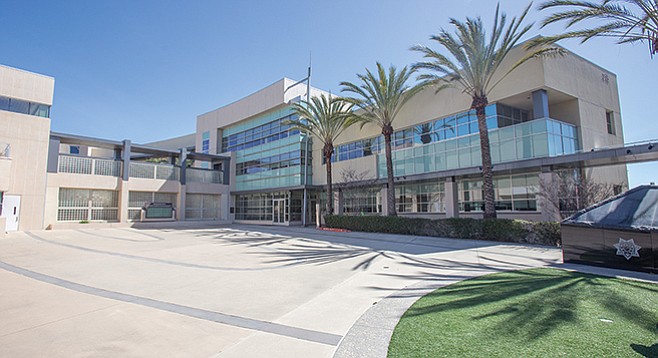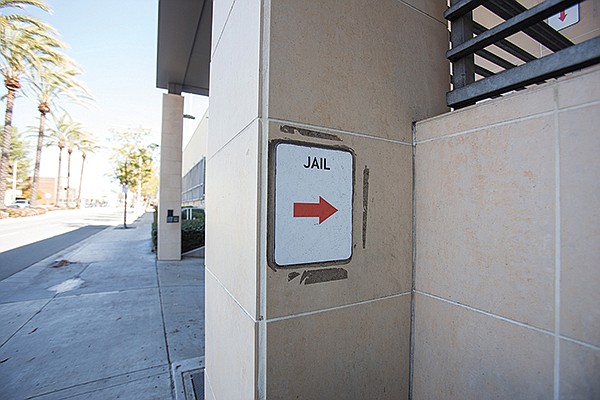 Facebook
Facebook
 X
X
 Instagram
Instagram
 TikTok
TikTok
 Youtube
Youtube

Was it wise for the City of Chula Vista to build a 48-bed jail? Is it really still serving the taxpayers ? Why, on almost any given day, is the jail filled with young Hispanic women? And why does the jail operate at a loss?
Back on January 8, by way of example, the Chula Vista jail had 24 detainees. They were all women, all Hispanic, and ranged in ages from 19 to 47, the average age being 29. The information on the Who’s in Jail? website for that day said that none of the women were bailable, all of them were United States Marshal inmates, and some were also on immigration and customs enforcement detainers.
A public record request to the city for more about the inmates yielded this response from police support services manager Barbara Brookover: “The Chula Vista jail merely leases space in our facility on behalf of the US Marshals Service…. The police department does not maintain records, criminal histories, nor data on legal representation.”

The Who’s in Jail? website publishes inmates’ names, birth dates, hair color, and ethnicity, so it was not difficult to locate inmates’ case numbers and attorneys. On January 11, I spoke with an attorney for one of the defendants. Kathryn Thickstun’s client (let’s call her Celia) is 23 years old.
Thickstun is an attorney appointed under the Criminal Justice Act to represent individuals in criminal cases who are financially unable to retain an attorney. “Each case is important. I defend the Constitution one person at a time.” But, Thickstun said, “Defending someone like Celia sometimes makes me feel like I’m beating my head against the wall.”
Celia was arrested for bringing methamphetamines across the border.
According to Thickstun, Celia had a valuable commodity — a border-crossing card. She used her card to come across and buy things in the United States that she then sold at a Tijuana swap meet. Thickstun said, “It was out of character for Celia to do what she did: she does not use drugs and never committed a crime. She was a student, worked as a volunteer in an emergency service in Tijuana, and, unlike some defendants, her whole family appeared in court.”
Celia committed this crime because her mother is terminally ill with a lung disease and needed medications that were beyond the family’s means, according to Thickstun. “Along the border, people with border-crossing cards, even teenagers, are regularly approached by drug smugglers.”
She said the people who came to Celia knew about her border-crossing pass, and they knew about her mother. They told her she would be transporting “medicine” that was illegal into the United States. “Celia had an inkling this wasn’t the truth, but she was desperate.” Nowadays, Thickstun said, what Celia feels desperate about is getting back into college.
“People like Celia are called mules or couriers. They are totally expendable to the drug organizations,” Thickstun said. In fact, she said that even though the inmates’ full names are posted on Chula Vista’s website, it would be safer not to use her real name.
“If drug organizations even think that someone has been talking, it could be dangerous for that person.”
In the sentencing process, Celia received reductions because of her circumstances, but she will never be able to enter the United States again. She was sentenced to a year and a day; some of her time will be served in the Chula Vista jail, the rest in a federal prison.

Some Chula Vistans wonder, is maintaining such a large jail in the best interest of the city?
When the city built the $66 million police station in 2004, they also built the 48-bed basement jail for an additional $3.1 million. A 2004 Union-Tribune article said, “The city will be paying about $3.9 million a year [for the station] until 2032 to pay off the debt.”
Those were the salad days of eastward development for Chula Vista and the article went on to say, “The city’s general fund will pick up 51.8 percent of the police station’s cost. The rest will come from fees developers pay to build homes in the city.”
The rationale for expanding from a 6-bed jail to a 48-bed jail has shifted through the years. In 2009 the grand jury investigated the efficacy of the only city-run jail in the county. The grand jury findings described the facility’s evolving purpose this way: “It was intended to hold prisoners for a maximum of 96 hours prior to initial arraignment and to reduce the transportation and other expenses related to booking prisoners into the San Diego County jail system. It was promoted at the time as a good tool to improve the quality of life for the community of Chula Vista by holding prisoners for arraignment who would otherwise be released on their own recognizance due to constraints at the San Diego County Sheriff’s Department facilities. Further, Chula Vista police investigators would have easier access to confined suspects requiring advanced examination.”
In 2009, at the time of the grand-jury investigation, the jail was involved in a gambit similar to the one with the U.S. Marshals Service. The jail housed 25–30 prisoners in a drug-rehabilitation program. According to the report, the city received $77 per day per prisoner, but the total operational expense was between $103.80 to $168.37 per day. The grand jury ascertained that the total operational expenses in 2007–2008 exceeded $1.7 million, while revenue from other agencies was about $700,000.”
Among other things, the grand jury concluded, “the City of Chula Vista needs a fiscal assessment to evaluate the efficiency and practicality of operating a jail facility by the Chula Vista Police Department.”
In July of 2011, the Chula Vista city jail entered into a contract to house female inmates for the United States Marshals Service. According to the police-department website: “Housing USMS inmates provides needed bed space for the Federal Government, while providing revenue to the city to offset the cost of the facility.”
But a look at numbers suggests U.S. Marshals inmates lose money for the city, just like the drug-rehabilitation inmates in 2009. According to information provided to the San Diego Reader by the City of Chula Vista, the Marshals Service pays $110 per day to house each of the inmates in the jail. But according to the same packet of information, “The City of Chula Vista’s daily cost to house an inmate is $155.71 per day.” That’s a daily loss of $45.71 per inmate.
Moreover, the revenue information provided by the city shows the jail continues to operate at a loss. The jail revenue for the fiscal year 2015 was $1,560,668. The revenue breakdown is: booking fees, $6218; training reimbursement, $7540; and Marshals Service contract, $1,546,910 (inmates housed at $110 per inmate per day).
But the jail expense (July 2014 to June 2015): $1,865,831. That’s an operating loss of $305,163.
The City of Chula Vista did not respond to requests for comment on the discrepancy. The city, though given ample opportunity, failed to provide requested information regarding the total construction debt that remains on the jail.


Was it wise for the City of Chula Vista to build a 48-bed jail? Is it really still serving the taxpayers ? Why, on almost any given day, is the jail filled with young Hispanic women? And why does the jail operate at a loss?
Back on January 8, by way of example, the Chula Vista jail had 24 detainees. They were all women, all Hispanic, and ranged in ages from 19 to 47, the average age being 29. The information on the Who’s in Jail? website for that day said that none of the women were bailable, all of them were United States Marshal inmates, and some were also on immigration and customs enforcement detainers.
A public record request to the city for more about the inmates yielded this response from police support services manager Barbara Brookover: “The Chula Vista jail merely leases space in our facility on behalf of the US Marshals Service…. The police department does not maintain records, criminal histories, nor data on legal representation.”

The Who’s in Jail? website publishes inmates’ names, birth dates, hair color, and ethnicity, so it was not difficult to locate inmates’ case numbers and attorneys. On January 11, I spoke with an attorney for one of the defendants. Kathryn Thickstun’s client (let’s call her Celia) is 23 years old.
Thickstun is an attorney appointed under the Criminal Justice Act to represent individuals in criminal cases who are financially unable to retain an attorney. “Each case is important. I defend the Constitution one person at a time.” But, Thickstun said, “Defending someone like Celia sometimes makes me feel like I’m beating my head against the wall.”
Celia was arrested for bringing methamphetamines across the border.
According to Thickstun, Celia had a valuable commodity — a border-crossing card. She used her card to come across and buy things in the United States that she then sold at a Tijuana swap meet. Thickstun said, “It was out of character for Celia to do what she did: she does not use drugs and never committed a crime. She was a student, worked as a volunteer in an emergency service in Tijuana, and, unlike some defendants, her whole family appeared in court.”
Celia committed this crime because her mother is terminally ill with a lung disease and needed medications that were beyond the family’s means, according to Thickstun. “Along the border, people with border-crossing cards, even teenagers, are regularly approached by drug smugglers.”
She said the people who came to Celia knew about her border-crossing pass, and they knew about her mother. They told her she would be transporting “medicine” that was illegal into the United States. “Celia had an inkling this wasn’t the truth, but she was desperate.” Nowadays, Thickstun said, what Celia feels desperate about is getting back into college.
“People like Celia are called mules or couriers. They are totally expendable to the drug organizations,” Thickstun said. In fact, she said that even though the inmates’ full names are posted on Chula Vista’s website, it would be safer not to use her real name.
“If drug organizations even think that someone has been talking, it could be dangerous for that person.”
In the sentencing process, Celia received reductions because of her circumstances, but she will never be able to enter the United States again. She was sentenced to a year and a day; some of her time will be served in the Chula Vista jail, the rest in a federal prison.

Some Chula Vistans wonder, is maintaining such a large jail in the best interest of the city?
When the city built the $66 million police station in 2004, they also built the 48-bed basement jail for an additional $3.1 million. A 2004 Union-Tribune article said, “The city will be paying about $3.9 million a year [for the station] until 2032 to pay off the debt.”
Those were the salad days of eastward development for Chula Vista and the article went on to say, “The city’s general fund will pick up 51.8 percent of the police station’s cost. The rest will come from fees developers pay to build homes in the city.”
The rationale for expanding from a 6-bed jail to a 48-bed jail has shifted through the years. In 2009 the grand jury investigated the efficacy of the only city-run jail in the county. The grand jury findings described the facility’s evolving purpose this way: “It was intended to hold prisoners for a maximum of 96 hours prior to initial arraignment and to reduce the transportation and other expenses related to booking prisoners into the San Diego County jail system. It was promoted at the time as a good tool to improve the quality of life for the community of Chula Vista by holding prisoners for arraignment who would otherwise be released on their own recognizance due to constraints at the San Diego County Sheriff’s Department facilities. Further, Chula Vista police investigators would have easier access to confined suspects requiring advanced examination.”
In 2009, at the time of the grand-jury investigation, the jail was involved in a gambit similar to the one with the U.S. Marshals Service. The jail housed 25–30 prisoners in a drug-rehabilitation program. According to the report, the city received $77 per day per prisoner, but the total operational expense was between $103.80 to $168.37 per day. The grand jury ascertained that the total operational expenses in 2007–2008 exceeded $1.7 million, while revenue from other agencies was about $700,000.”
Among other things, the grand jury concluded, “the City of Chula Vista needs a fiscal assessment to evaluate the efficiency and practicality of operating a jail facility by the Chula Vista Police Department.”
In July of 2011, the Chula Vista city jail entered into a contract to house female inmates for the United States Marshals Service. According to the police-department website: “Housing USMS inmates provides needed bed space for the Federal Government, while providing revenue to the city to offset the cost of the facility.”
But a look at numbers suggests U.S. Marshals inmates lose money for the city, just like the drug-rehabilitation inmates in 2009. According to information provided to the San Diego Reader by the City of Chula Vista, the Marshals Service pays $110 per day to house each of the inmates in the jail. But according to the same packet of information, “The City of Chula Vista’s daily cost to house an inmate is $155.71 per day.” That’s a daily loss of $45.71 per inmate.
Moreover, the revenue information provided by the city shows the jail continues to operate at a loss. The jail revenue for the fiscal year 2015 was $1,560,668. The revenue breakdown is: booking fees, $6218; training reimbursement, $7540; and Marshals Service contract, $1,546,910 (inmates housed at $110 per inmate per day).
But the jail expense (July 2014 to June 2015): $1,865,831. That’s an operating loss of $305,163.
The City of Chula Vista did not respond to requests for comment on the discrepancy. The city, though given ample opportunity, failed to provide requested information regarding the total construction debt that remains on the jail.
Comments